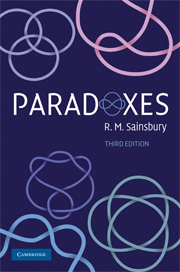Book contents
- Frontmatter
- Contents
- Foreword to third edition
- Introduction
- 1 Zeno's paradoxes: space, time, and motion
- 2 Moral paradoxes
- 3 Vagueness: the paradox of the heap
- 4 Acting rationally
- 5 Believing rationally
- 6 Classes and truth
- 7 Are any contradictions acceptable?
- Appendix I Some more paradoxes
- Appendix II Remarks on some text questions and appended paradoxes
- Bibliography
- Index
Appendix II - Remarks on some text questions and appended paradoxes
Published online by Cambridge University Press: 05 June 2012
- Frontmatter
- Contents
- Foreword to third edition
- Introduction
- 1 Zeno's paradoxes: space, time, and motion
- 2 Moral paradoxes
- 3 Vagueness: the paradox of the heap
- 4 Acting rationally
- 5 Believing rationally
- 6 Classes and truth
- 7 Are any contradictions acceptable?
- Appendix I Some more paradoxes
- Appendix II Remarks on some text questions and appended paradoxes
- Bibliography
- Index
Summary
Remark numbers refer to question numbers in the given chapter.
ZENO'S PARADOXES: SPACE, TIME, AND MOTION
1.2 One possible argument is this. If there were as many as two things, say α and β, then we could consider the whole W formed by these two things. Then W has α and β as its parts. So if nothing has parts, there are not as many as two things, i.e. there is at most one thing.
1.6 Yes, it does mean that the button will travel faster than the speed of light. Whether or not this is a logical possibility could be disputed, but it is fairly uncontroversial that it is not impossible apriori; that is, reasoning alone, unaided by experiment, cannot establish that nothing can travel faster than light.
1.8 “Going out of existence at Z★” might mean “Z★ was the last point occupied” or, alternatively, “Z★ was the first point not occupied.” The latter serves Benacerraf's cause against the objection.
VAGUENESS: THE PARADOX OF THE HEAP
3.11 He should deny the first premise. Since he believes that there are no heaps, he will think that it is false that a 10,000-grained collection is a heap. This shows that one should treat with care the taxonomy of responses described in the text. Unger's position, though in a sense unified, must be regarded as accepting the conclusion of some soritical arguments and denying the premises of others.
ACTING RATIONALLY
4.3 If a person's utilities can be measured in cash value terms, then his or her utilities are “commensurable”: of any two possible circumstances, either one has more utility than the other, or else they are of equal utility. However, if we think of very disparate “utilities,” it may be not merely that we do not know how they compare, but that there is no such thing as how they compare. For an early defense of commensurability see Rashdall (1907, ch. 2). For a more recent discussion see Nussbaum (1986, esp. pp. 107ff.).
[…]
- Type
- Chapter
- Information
- Paradoxes , pp. 168 - 171Publisher: Cambridge University PressPrint publication year: 2009



